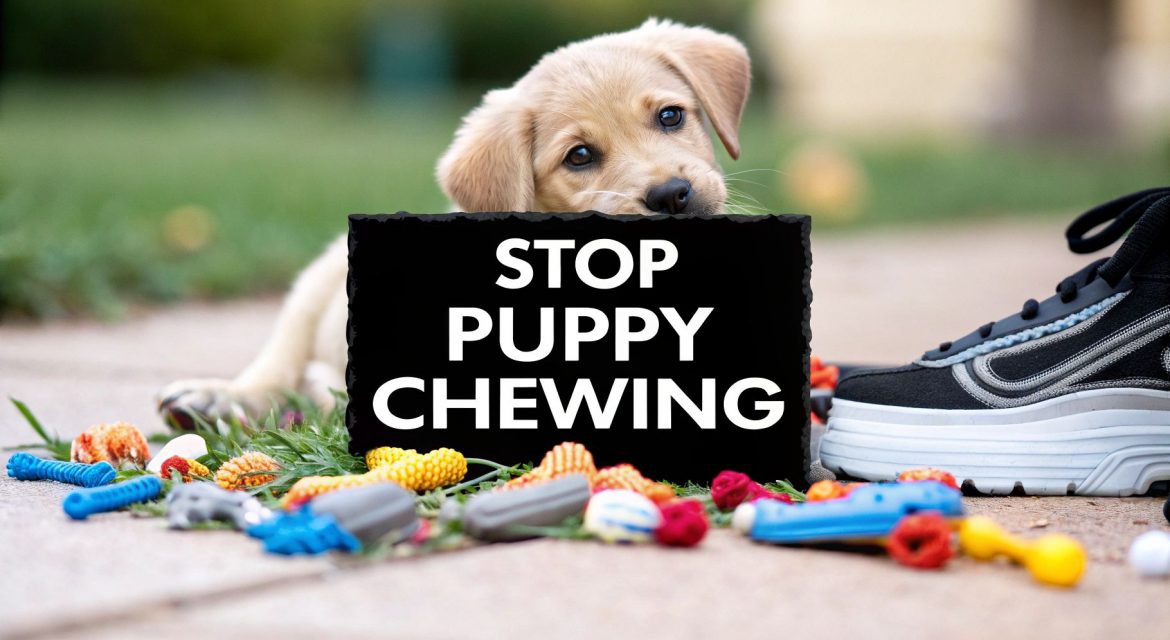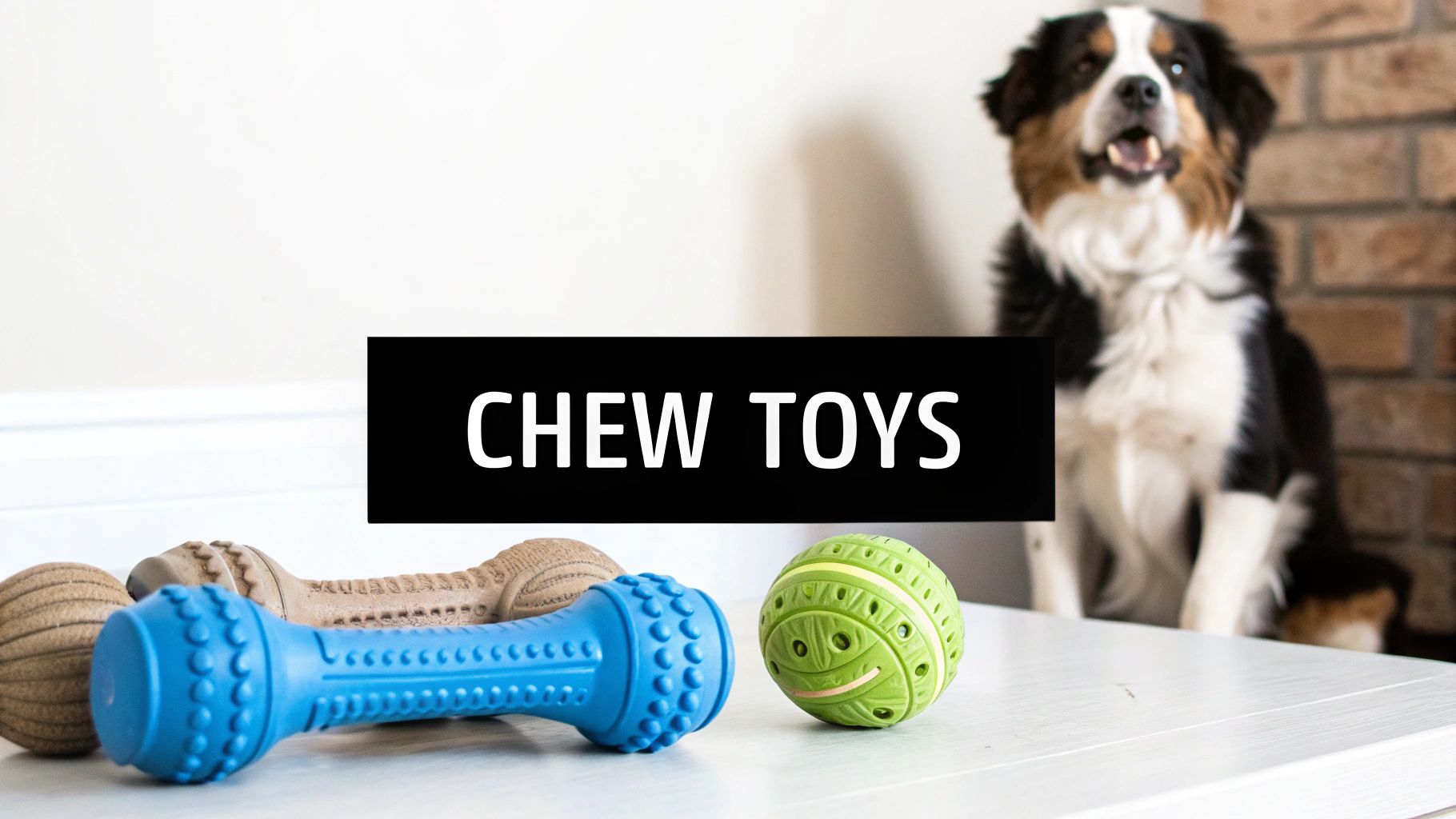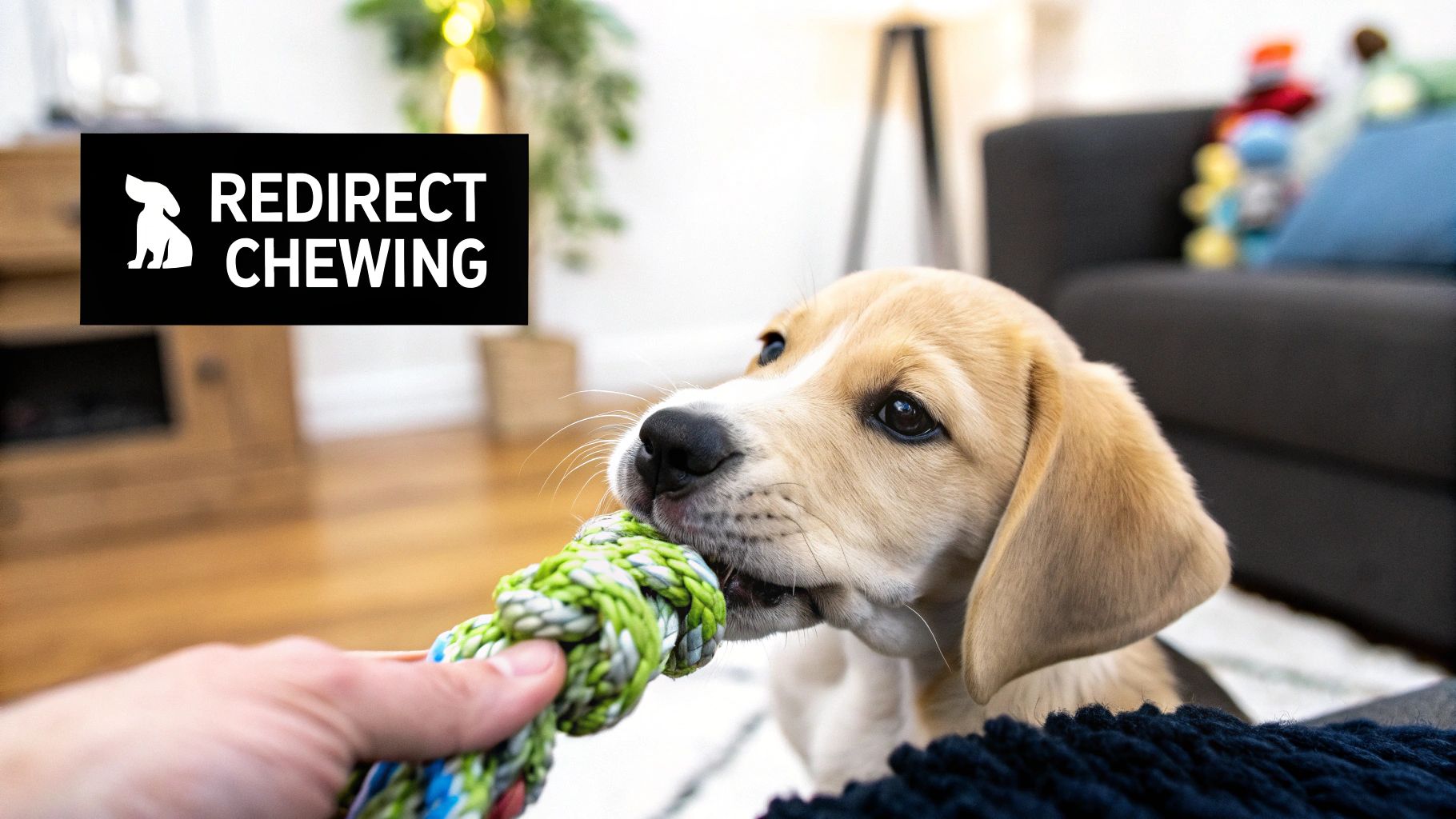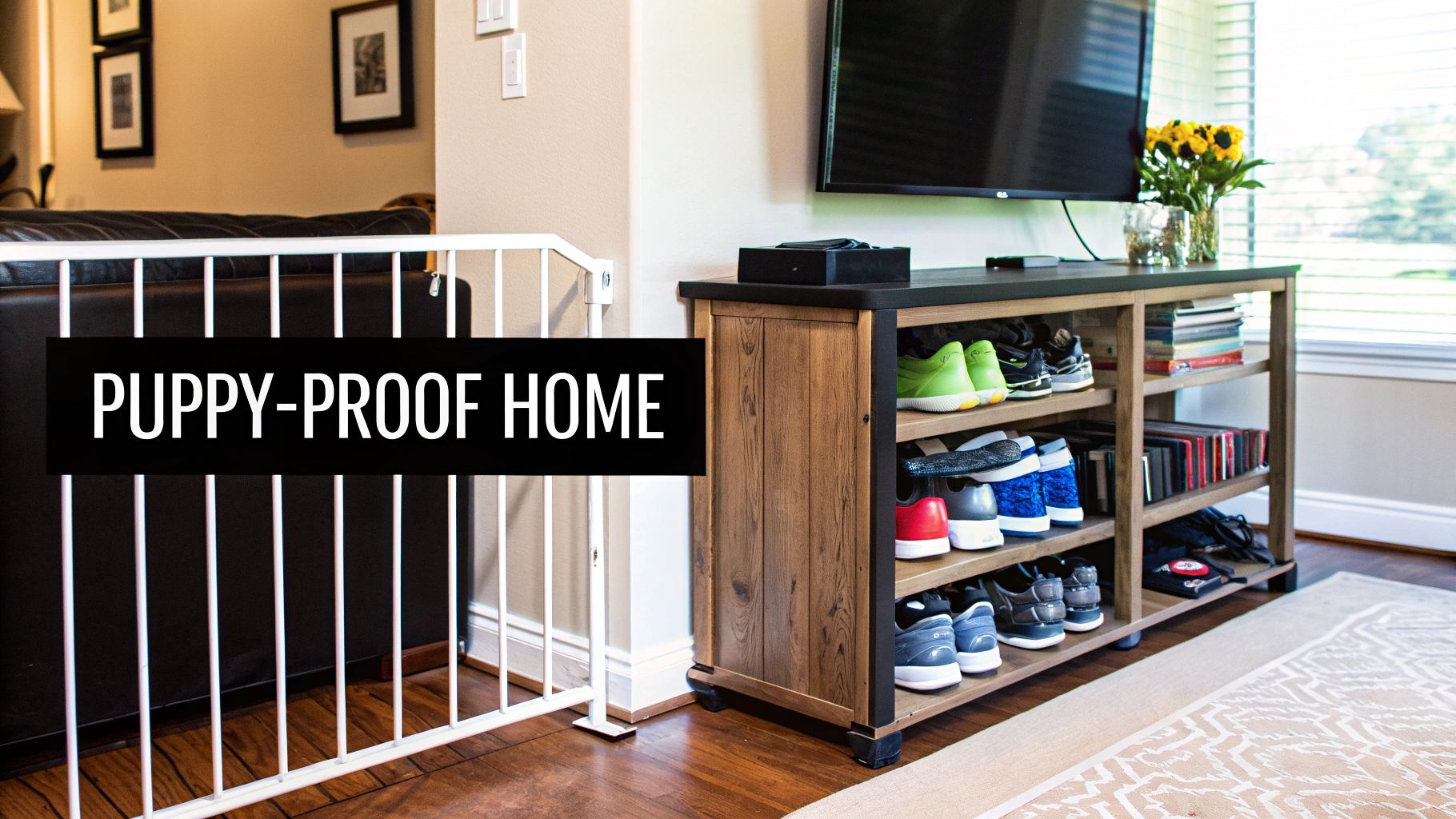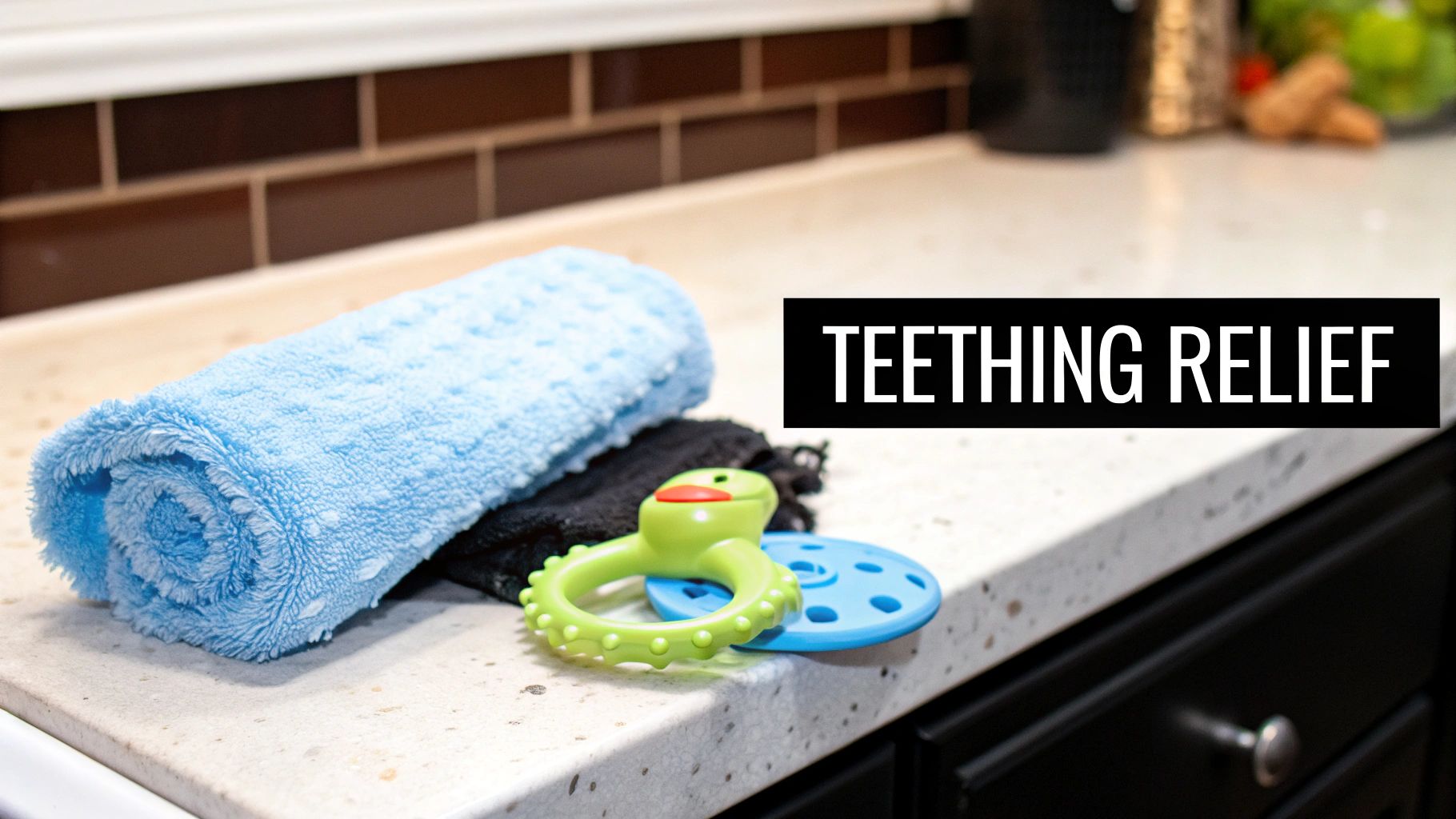That new puppy smell, those clumsy paws, the endless cuddles… it’s a wonderful time, isn’t it? But let's be honest, it also comes with a few challenges, and a big one is the constant chewing. It can feel like your home has suddenly become a giant, expensive chew toy. If you're finding yourself asking how to stop a puppy chewing, you're definitely not alone. We’ve all been there, rescuing a favourite pair of trainers from the jaws of a tiny terror.
The good news is that this is a completely normal, natural, and—most importantly—manageable behaviour. Chewing is a key part of how puppies explore their new world and soothe the discomfort of teething. Understanding this is the first step towards a peaceful home.
In this guide, we’re not just going to give you a list of 'don'ts'. Instead, we will walk you through eight compassionate and practical strategies that explain why your puppy chews and how you can redirect that instinct positively. Together, we'll turn those chewing woes into training wins, strengthening your bond every step of the way. Ready to reclaim your belongings and guide your new companion towards better habits? Let's begin.
1. Provide Appropriate Chew Toys
One of the most effective strategies to stop a puppy chewing on your furniture, shoes, and hands is to redirect their natural instinct onto something appropriate. A puppy’s urge to chew is a fundamental part of their development; it helps them explore the world, strengthen their jaw, and relieve the discomfort of teething. By providing a curated selection of safe and engaging toys, you’re not fighting this behaviour, but rather guiding it in a positive direction.
This approach, popularised by brands like Kong and Nylabone and championed by veterinarians, transforms chewing from a destructive problem into a constructive activity. It satisfies your puppy’s needs while simultaneously protecting your belongings and promoting healthy dental development.
How to Choose the Right Toys
The key is variety and safety. Your puppy will appreciate different textures and challenges to keep them mentally stimulated.
- For Teething Pups: A frozen, damp washcloth or a specially designed teething toy can provide immense relief for sore gums. We know it sounds simple, but the cold helps numb the area, making the teething process more bearable.
- For Mental Stimulation: Puzzle toys like the classic Kong are brilliant. You can fill them with dog-safe peanut butter, wet food, or soaked kibble and then freeze them to create a long-lasting, rewarding challenge.
- For Strong Chewers: If you have a puppy with a powerful jaw, look for durable options like Nylabone DuraChew toys. These are designed to withstand serious gnawing without splintering into dangerous pieces.
Pro Tips for Success
To get the most out of this strategy, we always recommend supervising your puppy with a new toy. Rotate their collection every week to prevent boredom and maintain their interest; a toy they haven't seen for a few days can feel brand new again. Make sure any toy you choose is slightly larger than their mouth to avoid a choking hazard. By making their designated toys more exciting than your table legs, you're setting them, and your home, up for success.
2. Use Positive Redirection Training
Beyond just providing the right toys, you need to actively teach your puppy what they should be chewing. This is where positive redirection training comes in. Rather than punishing your puppy for chewing the wrong thing, you calmly interrupt the behaviour and guide them towards an acceptable alternative. This method effectively teaches them the rules of the house without creating fear or anxiety.
This approach is championed by leading animal behaviourists like Patricia McConnell and Karen Pryor. It focuses on building positive associations, ensuring your puppy learns that chewing their own toys leads to praise and rewards, which is far more appealing than gnawing on a chair leg. It’s a foundational technique for how to stop a puppy chewing destructively and is central to modern, humane dog training.
How to Implement Redirection
The key is to be consistent, calm, and quick. The moment you see your puppy chewing something they shouldn't, you need to intervene in a positive way.
- Interrupt and Offer a Trade: If you catch your puppy chewing your shoe, make a calm sound to get their attention, like a gentle clap. Immediately offer them a high-value rope toy or a tasty chew treat. When they release the shoe to take the toy, praise them enthusiastically.
- Redirect from Furniture: When your puppy starts chewing on the sofa, don't shout. Instead, guide them away and present them with an exciting puzzle toy like a filled Kong. This makes the toy a more engaging option than the furniture.
- Mark the Right Choice: For a more advanced approach, you can use a clicker. The moment your puppy chooses their toy over an inappropriate item, click and reward. This clearly marks the desired behaviour and speeds up the learning process.
Pro Tips for Success
To make this training effective, preparation is everything. We recommend always keeping appropriate toys easily accessible in every room your puppy uses. Use high-value rewards, like a special treat they only get during training, to make successful redirection more impactful. Remember to stay patient; this process takes time and repetition. By staying consistent, you’re teaching your puppy a valuable life skill.
3. Puppy-Proof Your Environment
While redirecting your puppy to appropriate toys is crucial, an equally important strategy is proactive management of their environment. Puppy-proofing your home means removing temptation before it can become a problem. This preventative approach is all about setting your puppy up for success by making it impossible for them to chew on dangerous or valuable items.
This method, strongly advocated by professional dog trainers and veterinary behaviourists, is a cornerstone of responsible puppy ownership. It prevents the formation of bad habits and, most importantly, keeps your curious companion safe from potential hazards like electrical wires or toxic substances. It’s a simple case of “out of sight, out of mind.”
How to Puppy-Proof Effectively
Getting started requires you to see the world from your puppy's perspective. Get down on the floor and look for anything within their reach that could be a tempting chew target. We know it sounds a little silly, but it works!
- Secure Your Belongings: Keep shoes in a closed wardrobe, books on high shelves, and remote controls or mobile phones well out of reach. Think about anything you value and put it away.
- Manage Cords and Wires: Electrical cables are extremely dangerous. We can’t stress this enough. Tuck them behind furniture, run them through cord protectors, or use cable management boxes to prevent access.
- Restrict Access: Use baby gates to block off rooms with numerous hazards or delicate furniture. This gives your puppy a safe, designated area to explore without constant supervision.
Pro tips for Success
To make your puppy-proofing efforts foolproof, be consistent and thorough. Remember that as your puppy grows, their reach will increase, so you may need to adjust your setup. Applying a bitter-tasting but pet-safe spray to immovable objects like furniture legs can be an excellent deterrent for persistent chewers. As your puppy matures and their training progresses, you can gradually reintroduce items, teaching them what is and isn't theirs. This management strategy isn't forever, but it is an essential foundation for a well-behaved adult dog.
4. Address Teething Discomfort
If your puppy is between three and six months old and has suddenly become a chewing machine, there’s a good reason: teething. Just like human babies, puppies experience significant discomfort as their adult teeth push through their gums. This pain often drives an intense urge to chew, as the pressure on their gums provides temporary relief. Addressing this discomfort directly is a crucial step in how to stop a puppy chewing everything in sight.
This focused approach is strongly advocated by veterinary dentists and experienced breeders. It recognises that the chewing isn't just a behavioural issue but a physiological need. By providing safe, soothing solutions, you can ease their pain, protect your belongings, and guide them through this developmental phase with care and understanding.
How to Soothe Sore Gums
The key is using cold temperatures to numb the pain and providing safe textures for them to gnaw on. This combination makes their appropriate chew items far more appealing than your wooden chair legs.
- Frozen Treats: A Kong toy stuffed with puppy-safe peanut butter or their wet food and then frozen is a fantastic option. The cold soothes their gums while the treat keeps them engaged.
- Chilled Cloths: A simple, damp washcloth twisted and frozen for about 30 minutes creates an excellent, textured chew toy. It’s soft enough not to damage incoming teeth but firm enough to offer relief.
- Specialised Teething Toys: Many pet shops sell toys with gel inserts designed to be frozen. These hold the cold for longer and provide a unique chewing sensation.
- Cold Veggies: For supervised chewing sessions, a frozen carrot or a few chilled apple slices (with seeds removed) can be a healthy and satisfying treat for a teething pup.
Pro Tips for Success
To make this strategy effective, timing and supervision are essential. We suggest offering these cold items for 10-15 minute intervals, especially after a nap or when you notice them getting restless. Always monitor your puppy to ensure frozen items don't become hard enough to pose a risk. You can also gently massage their gums with a clean finger to provide extra comfort. If your puppy seems to be in unusual pain, a consultation with your vet is always a good idea.
5. Increase Physical Exercise and Mental Stimulation
A tired puppy is a well-behaved puppy. Often, destructive chewing isn't just about teething; it's a symptom of boredom and pent-up energy. By increasing your puppy's physical exercise and mental stimulation, you provide healthy outlets for their natural exuberance, significantly reducing the likelihood that they'll see your coffee table as a source of entertainment.
This holistic approach is widely endorsed by canine behaviourists and veterinarians who recognise that behaviour problems often stem from unmet needs. Engaging your puppy's body and mind satisfies their instincts, strengthens your bond, and channels their energy into constructive activities, leaving them content to rest peacefully afterwards.
How to Implement This Strategy
The goal is to thoughtfully engage your puppy, not just exhaust them. A balance of physical and mental challenges will be most effective in curbing unwanted chewing.
- Mental Challenges: Use puzzle feeders to make meal times a fun brain game. Short, 10-15 minute training sessions teaching commands like "sit," "stay," or "leave it" are fantastic mental workouts that also reinforce good manners.
- Structured Play: Supervised games of fetch in a secure garden are excellent for burning off energy. For rainy days, indoor hide-and-seek games with their favourite toy or healthy treats can be just as stimulating. For more ideas, you can explore a variety of indoor dog games.
- Appropriate Physical Exercise: Follow the "five-minute rule" as a general guideline: five minutes of structured exercise per month of age, twice a day. This prevents over-exercising, which can harm their developing joints.
Pro Tips for Success
To integrate this into your routine, schedule active periods just before you need your puppy to be calm, like before you start work or settle down for the evening. Rotate their activities and training exercises regularly to keep things fresh and exciting, preventing them from becoming bored with the same old routine. By proactively managing their energy levels, you are addressing the root cause of much problem chewing, setting your puppy up for a lifetime of good behaviour.
6. Use Taste Deterrents
Sometimes, despite your best efforts with redirection and management, your puppy might remain fixated on a particular forbidden item. In these cases, taste deterrents offer a safe and effective way to teach your puppy that chewing on certain objects is simply not a pleasant experience. This method works by applying a non-toxic, bitter-tasting substance to surfaces, creating a negative association that discourages future gnawing.
This training aid, first popularised by products like Grannick's Bitter Apple, is now a go-to tool for professional dog trainers and veterinarians. It addresses the issue directly at the source, making the act of chewing on furniture, skirting boards, or cables inherently unrewarding for your puppy, thus helping you protect your home while guiding their behaviour.
How to Choose the Right Deterrent
The goal is to find a taste your puppy dislikes without causing them any harm. Not all dogs react the same way, so you may need to experiment to find what works for your pup.
- Commercial Sprays: Products like Grannick's Bitter Apple are specifically formulated to be safe for pets but have a powerful bitter taste. They are ideal for use on furniture legs, shoes, and wooden trims.
- Natural Alternatives: For a DIY approach, you can use natural substances that dogs find unappealing. A diluted solution of white vinegar can work on hard surfaces, while the scent from citrus peels (lemon or orange) can deter chewing on fabrics.
- Fabric-Specific Formulas: Some sprays are designed specifically for soft furnishings to prevent staining or damage. Always check the label to ensure it's suitable for the material you intend to treat.
Pro Tips for Success
To ensure this method is effective, consistency is crucial. First, always test any spray on a small, hidden area to check for discolouration. Reapply the deterrent every few days, as its potency will fade over time. Most importantly, combine this technique with positive reinforcement; when your puppy turns away from a treated item, immediately praise them and offer an appropriate chew toy. This teaches them not just what not to chew, but what they should chew instead.
7. Establish Consistent Daily Routines
One of the most powerful, yet often overlooked, strategies for how to stop a puppy chewing is to provide a predictable daily structure. Puppies thrive on consistency; a regular routine for feeding, play, training, and rest reduces anxiety and boredom, which are two major triggers for destructive chewing. When a puppy knows what to expect and when, they feel more secure and are less likely to act out their stress on your belongings.
This approach is heavily endorsed by professional dog trainers and veterinary behaviourists. They recognise that a structured day provides mental stability for a young dog, channelling their energy into scheduled activities rather than random, destructive impulses. It’s about creating a calm, organised environment where your puppy can flourish without feeling the need to chew out of uncertainty.
How to Create a Puppy Routine
A successful routine is balanced and meets all your puppy’s developmental needs. Consistency is the most important element, especially during the first few months.
- Morning Schedule: Start the day consistently. For example, a 7 AM wake-up call for a toilet break, followed by breakfast, and then a short, engaging training session or a walk.
- Midday Activities: Plan for a midday toilet break and a period of managed activity. This is an ideal time for a puzzle toy or a supervised play session to burn off some energy before they settle down for a nap.
- Evening Wind-Down: Your evening routine should signal that the day is coming to a close. This could include some gentle family interaction, a final toilet trip, and then settling into their crate or bed for the night.
Pro Tips for Success
To make your routine stick, it’s crucial to maintain it even on weekends and holidays, as puppies don't understand the concept of a day off. We’ve all been there! Use consistent verbal cues or physical signals, like picking up their lead, to signify what is about to happen next. As your puppy grows, you can gradually adjust the timings, but always aim to keep the sequence of events the same. This predictability is your secret weapon against anxiety-driven chewing.
8. Supervise and Use Proper Timing
One of the most powerful tools in your arsenal to stop a puppy chewing on forbidden items is constant, active supervision. A puppy left to their own devices will inevitably make mistakes, but by keeping a close watch, you can prevent bad habits from ever forming. This strategy is all about proactive management and immediate, gentle correction, which is vital for a young dog with a short attention span.
This method, championed by professional dog trainers and animal behaviourists, is foundational to puppy development. It teaches your puppy the household rules through consistent guidance rather than punishment. By managing their environment and being present, you set them up for a lifetime of good choices, strengthening the bond between you both.
How to Implement Effective Supervision
The goal is to make it easy for your puppy to succeed. This means limiting their access to potential trouble spots until they’ve learned what’s off-limits.
- Create Puppy-Safe Zones: Use baby gates or playpens to confine your puppy to a single, puppy-proofed room where you can easily watch them. This removes the temptation of chewing on electrical cords or expensive furniture in other parts of the house.
- Use a Tether: When you're busy around the house, tethering your puppy to you with a lightweight, 6-foot lead can be a game-changer. This keeps them within your sight and prevents them from wandering off to chew on a skirting board.
- Embrace the Crate: For short periods when you absolutely cannot supervise, a crate is an invaluable tool for keeping your puppy safe and out of mischief. If you need help, you can learn more about how to crate train a puppy to make it a positive experience.
Pro Tips for Success
Timing is everything. A correction is only effective if it happens the instant the unwanted behaviour begins. We suggest using a positive interruption sound like a sharp "ah-ah!" or a clap to get their attention, then immediately redirect them to an appropriate chew toy. Always praise them enthusiastically when they switch to the right item. As your puppy matures and demonstrates consistently good behaviour, you can gradually grant them more freedom.
8 Effective Puppy Chewing Prevention Methods Comparison
| Method | Implementation Complexity 🔄 | Resource Requirements ⚡ | Expected Outcomes 📊 | Ideal Use Cases 💡 | Key Advantages ⭐ |
|---|---|---|---|---|---|
| Provide Appropriate Chew Toys | Moderate: Selecting and rotating toys | Moderate: Cost and replacement needed | Reduces destructive chewing, promotes dental health | Puppies with natural chewing instincts needing safe outlets | Satisfies chewing urge, mental stimulation |
| Use Positive Redirection Training | High: Requires consistency and supervision | Low to Moderate: Training effort | Builds positive chewing habits, strengthens owner-puppy bond | Puppies needing behavioral guidance and positive learning methods | Effective, humane, teaches decision-making |
| Puppy-Proof Your Environment | High: Initial setup effort | Low to Moderate: Barriers and deterrents | Prevents destructive behavior before it starts | Homes with many tempting objects and valuable belongings | Protects property, reduces stress |
| Address Teething Discomfort | Moderate: Requires specific items | Moderate: Special toys and monitoring | Provides relief from teething pain, reduces anxiety | Puppies 3-6 months old experiencing teething pain | Directly targets pain cause, soothes discomfort |
| Increase Physical Exercise and Mental Stimulation | High: Regular time investment | Low to Moderate: Toys and activities | Reduces boredom-induced chewing, improves health | Puppies with excess energy and need for mental challenges | Addresses root cause, promotes wellbeing |
| Use Taste Deterrents | Low: Simple application | Low: Purchase of sprays or deterrents | Reduces chewing on treated items via taste aversion | Owners seeking passive, 24/7 protection measure | Safe, humane, works without supervision |
| Establish Consistent Daily Routines | Moderate: Requires household commitment | Low: Scheduling and monitoring | Reduces stress-induced chewing, builds good habits | Puppies with anxiety or stress-related chewing issues | Creates security, improves predictability |
| Supervise and Use Proper Timing | High: Demands constant attention | Low to Moderate: Time and management | Prevents bad habits, enhances learning with immediate feedback | Puppies during high-risk chewing periods | Early intervention, strong communication |
Chewing is Just the Beginning: Your Journey Together
Navigating the choppy waters of puppyhood, especially the relentless chewing phase, can feel like a monumental task. As we've explored, learning how to stop a puppy chewing on your favourite slippers or the corner of the rug isn't about punishment or suppression. Instead, it’s a journey of understanding, redirection, and building a powerful bond with your new family member. You are their guide, their teacher, and their source of comfort as they figure out this big, new world.
Let's recap the core pillars of our strategy. The most effective approach is a multifaceted one, combining proactive management with compassionate training. We started by puppy-proofing your home, creating a safe haven where your pup can explore without constant temptation. We then emphasised the power of providing an arsenal of appropriate chew toys, giving them a "yes" for every "no." Remember, a bored puppy is a destructive puppy, which is why we highlighted the crucial role of physical exercise and mental stimulation in channelling their boundless energy into positive outlets.
From Chewing to Cherishing
The real breakthrough happens when you combine these environmental strategies with consistent, positive training. Redirection is your most powerful tool. Catching them in the act and lovingly swapping a chair leg for a Kong isn't just saving your furniture; it's a micro-lesson in communication. You're teaching them the rules of the house in a language they understand. Consistency, as we discussed, is the glue that holds it all together. A predictable routine for meals, walks, and playtime helps your puppy feel secure, reducing the anxiety that often fuels destructive chewing behaviours.
Think of this stage not as a problem to be solved, but as your first major collaborative project. Every time you successfully redirect your puppy, you reinforce your role as a trusted leader. Every time you provide a frozen carrot to soothe their teething gums, you show them you understand their needs. Mastering these techniques now does more than just solve the immediate issue of chewing. It lays the groundwork for all future training, establishing a relationship built on mutual respect and clear communication.
The journey of how to stop a puppy chewing is fundamentally about teaching, not just telling. It’s about being patient when you find another gnawed-on sock and celebrating the small victories when they choose their toy over the television remote. This phase will pass sooner than you think, and with these strategies, you'll emerge on the other side with more than just intact belongings. You’ll have a well-behaved, confident, and happy companion who understands the boundaries of their home and trusts you implicitly to guide them. You’re not just raising a puppy; you’re building a friendship for life.
Ready to take your puppy-parenting skills to the next level? At My Life My Dog, we offer a wealth of resources, from in-depth training guides to expert advice on everything from nutrition to behaviour. Continue your journey with us and discover everything you need to build an incredible life with your best friend at My Life My Dog.


